ITV’s Poirot series ran from 1989 to 2013, and by its conclusion had covered just about every novel or short story featuring the Belgian detective that Agatha Christie wrote. The series was, and continues to be, hugely popular, and the face of David Suchet as Hercule Poirot is one of the most instantly-recognised faces anywhere in the world.

When the series began, it concentrated on the early short stories featuring Poirot as a consulting detective based at Whitehaven Mansions in London, with his associate Captain Hastings, secretary Miss Lemon and Inspector Japp, an old sparring partner from Scotland Yard. These programmes were each just under an hour long, and perfect light-hearted fare for Sunday nights. When the producers turned their attention to the full-length Poirot novels, where possible they would try to shoe-horn Japp, Hastings and Lemon into the story whether they had appeared in the original or not.
This continued to be the case until 2003, by which time the producers realised that the series had become just a trifle tired and formulaic. A decision was made to concentrate on Poirot working on his own, as had been the case in most of the original books anyway.
A New Start
The first programme in this new format was an adaptation of Five Little Pigs, a story in which Poirot is commissioned by Lucy Lemarchant to investigate the murder of her father sixteen years (fourteen in the film) previously, a crime of which her (now-deceased) mother Caroline had been convicted. Lucy had only been a small child at the time, but Caroline had written a letter to her protesting her innocence – a letter withheld from Lucy until she reached the age of 21.
Poirot agrees to investigate the past, and talk to those also present at the time of Amyas’ death. They are Philip and Meredtith Blake, Elsa Greer, Miss Williams and Angela Warren – the five little pigs.
The resultant film proved to be a triumphant vindication of the producers change of direction.
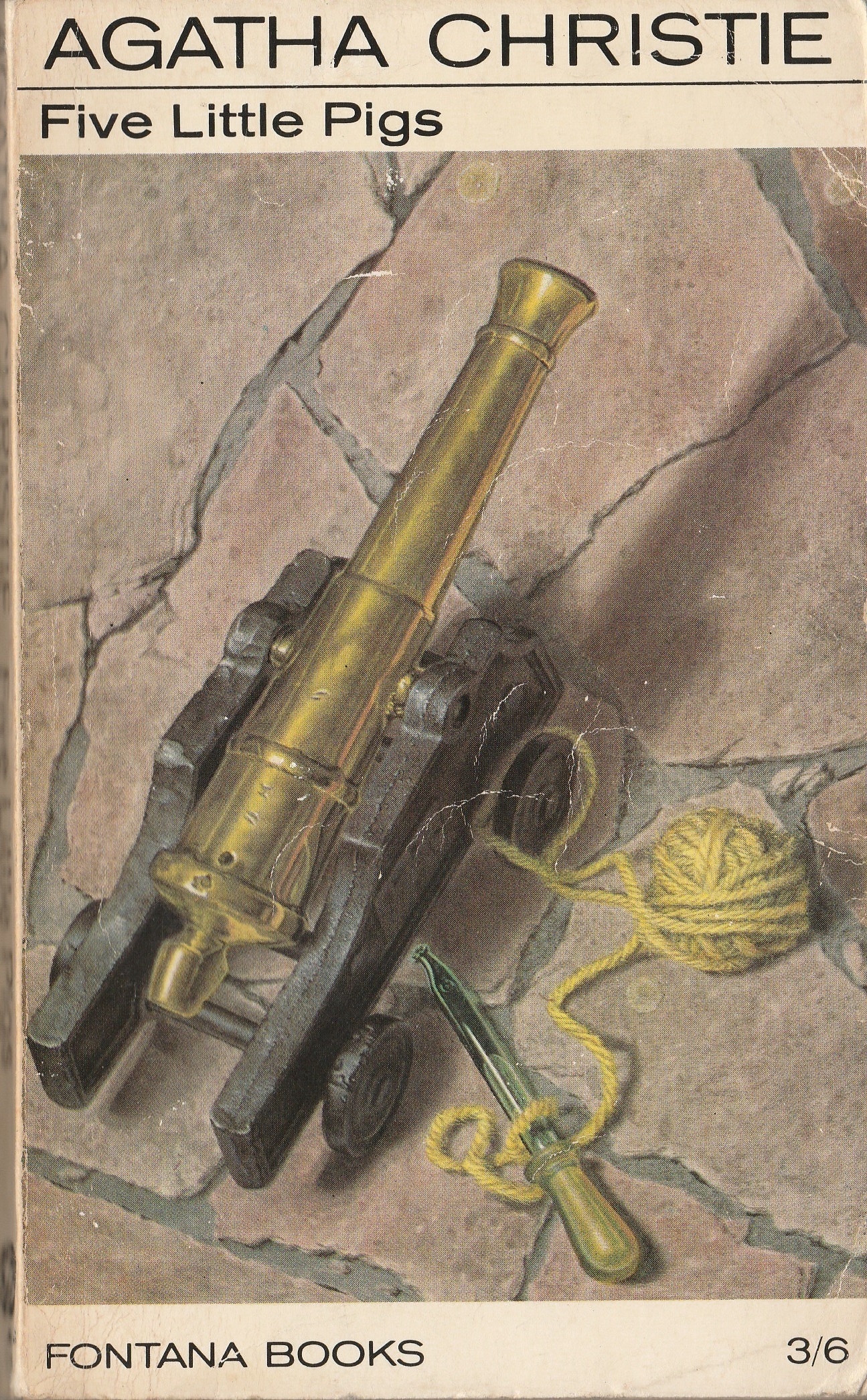
True to the Original
Five Little Pigs is not the easiest novel to televise, consisting as it does of five characters reminiscing verbally, and then in writing, to Poirot about the events of many years before. During the course of the book nothing else happens, there are no fresh incidents or crimes to spice things up, there are no humorous interludes. This is a dark tale and Poirot is almost a minor character.
There must have been a great temptation to add extra elements of drama or humour to the story, as the series had often done, but the producers resisted here, with one exception: Caroline Crale is hanged for murder, rather than quickly dying in prison.
This addition meant that the production could concentrate on stressing the tragic nature of what had happened and describing the haunting impact it still had on those who were present at the time. It achieves this by using strong character actors to bring depth to each of the main protagonists, by the use of different styles of camerawork and lighting to depict the past and the present, and by the careful choice of music to illustrate the tragedy of the Crale family.
What is most unusual about this particular Poirot episode is that some elements of it are so subtle that they only become obvious on a second or third viewing. Someone clearly took huge care with this production. Here are some examples from the screenplay, the music, the filmwork and the casting.
The Alice Blue Gown
Although Poirot’s novel career lasted from 1920 – 1969, the TV episodes were typically set in 1936. The events leading up to the murder of Amyas Crale would therefore have occurred in the early 1920s, and the costumes and sets reflect this.
The film begins with a seven-year-old Lucy winding up a record player and playing a new ’78 before dressing up in one her mother’s dresses and joining her parents on the terrace.
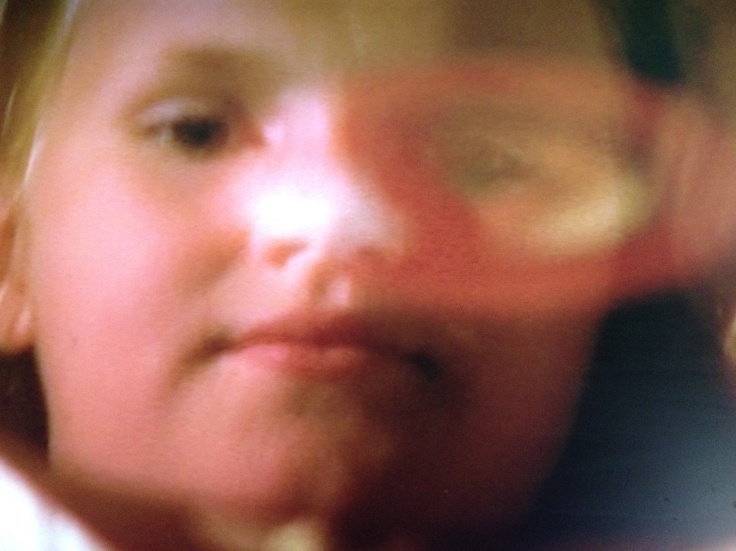
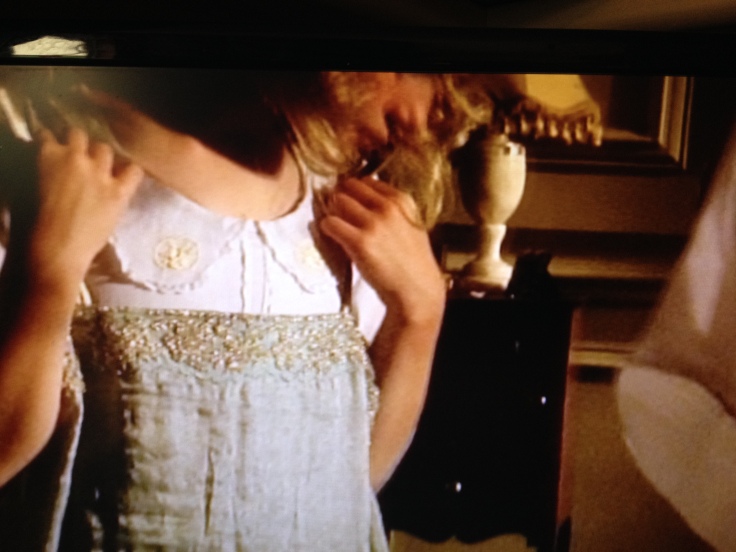
This is a scene from an apparently idyllic summer, but by the end of it both the parents are dead and Lucy herself sent to live with relatives abroad.
The record Lucy plays is “Alice Blue Gown”, recorded in 1920 by Edith Day. ‘Alice Blue’ was a particular colour favoured by Alice Roosevelt, daughter of the American President, and all the rage at the time; it is also the colour of her mother’s dress that Lucy tries on.
Fourteen years later, the same song is playing in the background as the Five Little Pigs make their way to a re-union at the scene of the crime. Lucy digs out the same dress from her mother’s old dressing-room to wear before she goes downstairs to confront them.
This level of attention to one small detail, introduced right at the start and then again at the end, surprised me. Not once in the film, even at the end, is any explicit mention of the dress made by anyone, nor is any indication of the song’s title given. It is only as a result of re-watching Five Little Pigs that I even noticed it.
The Music
The theme music for the Poirot series was composed by Christopher Gunning, and for most episodes cases all of the incidental music as well.
For Five Little Pigs, however, this was not the case. Apart from ‘Alice Blue Gown’, and an excerpt from the Love Duet from Tristan and Isolde, there is the haunting piano music of Erik Satie (‘Gnossienne No 1‘): ¹
I asked Chris about its inclusion:
“I didn’t choose the piece. It was chosen by the director because he liked it, but he only suggested it for one section. I then suggested we use it in various other sections so as to provide continuity and varied the orchestrations to be suitable for those additional sections. I was happy with this, because I also loved the piece. I thought the result made for a more interesting score overall than some other episodes – I also only used the “famous” theme right at the end.”
This is an inspired choice of music because, alongside the film-work, it manages to underline the feeling of loss of each of the main characters – whether the loss of innocence, or family, or the only person that they ever loved .
Chris composed two other main themes for the film – Amyas Crale’s Last Painting, and The Innocence of Caroline Crale, which is interlaced with the Satie piece throughout. ²
The Filming
The story encompasses three periods – the seemingly idyllic childhood summer holidays of the Crales and the Blakes prior to the First World War, the more obviously idyllic but ultimately fateful summer of the early 1920s, and the darker summer of the mid-1930s, during which the truth is allowed to reveal itself. Each of these periods is filmed differently.
The childhood sequence is somewhat fuzzy, like a silent home movie. It is slightly disturbing, hinting at the conflicting emotions of the four young people even then. The fuzziness also has the effect of allowing the young ones to closely resemble their older counterparts.
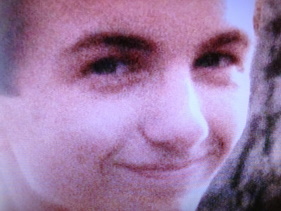

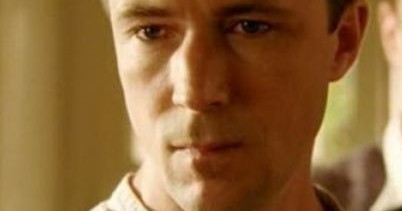
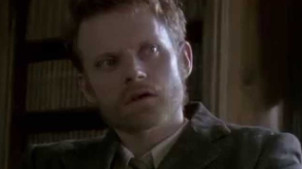
As the five little pigs recollect their memories of the fateful events of the 1920s, the flashback filming is done by hand-held camera, giving the impression to the audience that they are also witness to events, or even filming it themselves.³ The atmosphere is light and airy throughout, almost hazy, including the sequence when Amyas is killed: maybe that is a reflection of the hazy nature of the little pigs’ memories.
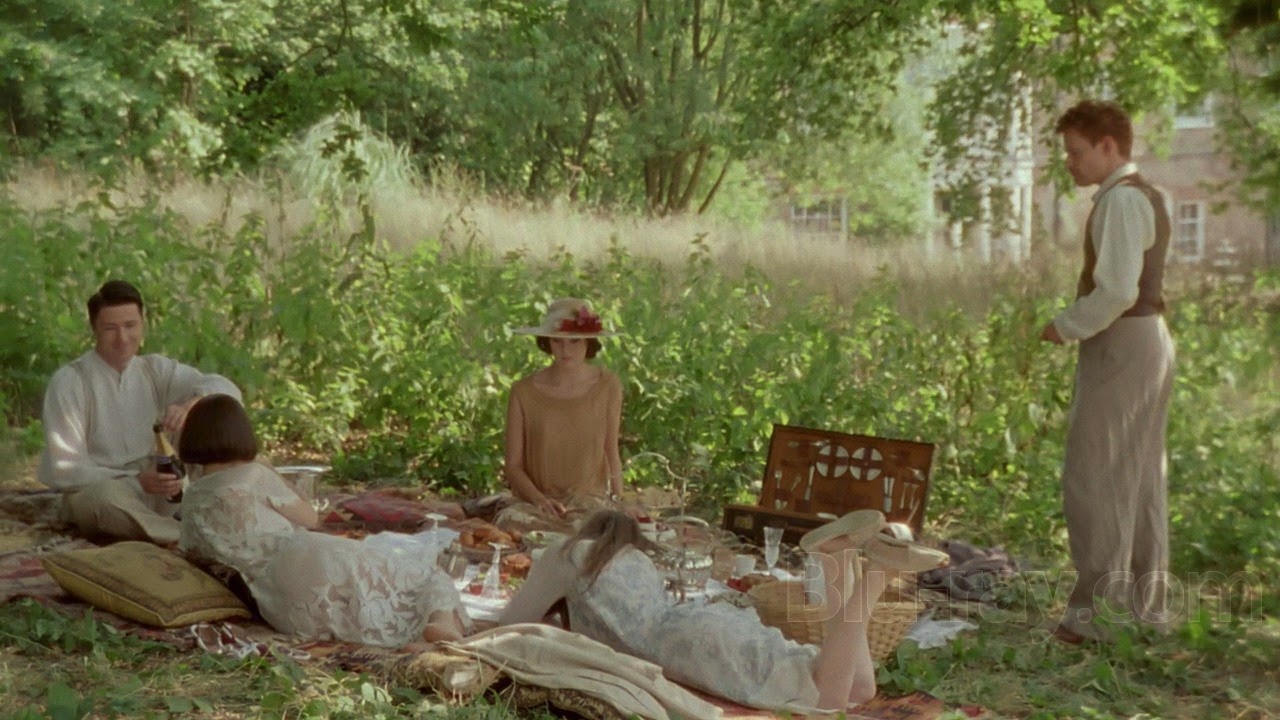
By contrast, the later sequences featuring Poirot, his interviews and explanation, are all fully-focussed and sharp, and almost uniformly stark and colourless. The little pigs have aged by fourteen years but no make-up is needed to illustrate the passage of time.
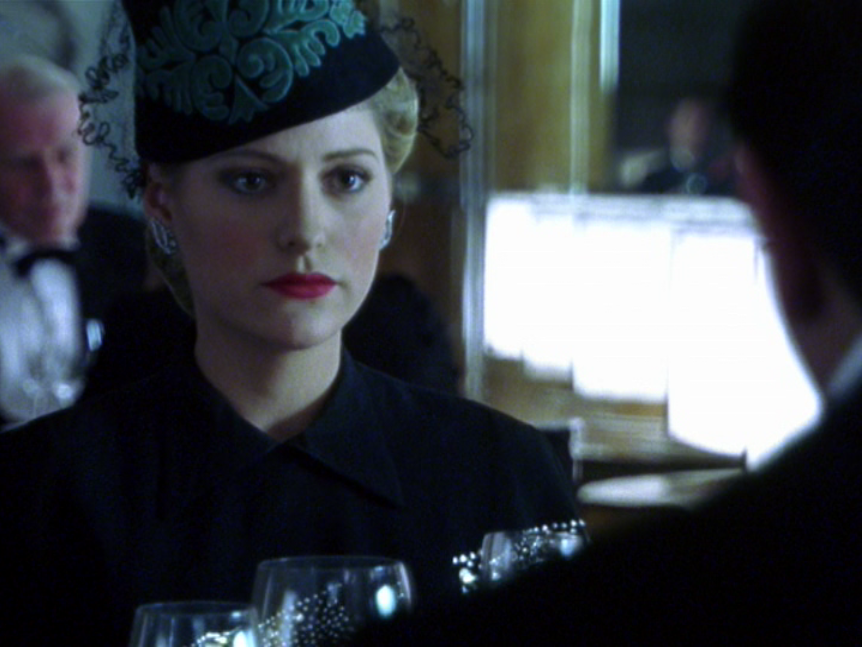
This bleakness underlines how much each character has been haunted by the events of that long, hazy summer fourteen years previously, and how each of them has lost something then that they can never hope to reclaim. There is no ‘closure’ in this film.
Liberties taken
You can never have an Agatha Christie adaptation without the producers thinking that somehow they are going to be able to improve on the original.
The main change to the original is shown right at the start – the hanging of Caroline Crale (in the book she dies in prison). The rest of the film takes place almost in the shadow of this event. Every time Caroline is remembered, often accompanied by her own theme music, it is more poignant because we already know what lies in store for her.
I doubt whether Agatha Christie would have approved of the hanging, but I am sure she would have snorted somewhat at other, somewhat petty changes: the events described taking place fourteen, rather than sixteen years previously; the child Carla’s name being changed to Lucy; Elsa’s age being reduced to 18, and Caroline’s failure to seduce Philip, rather than the other way round.
The other major plot change occurs at the end, when Lucy pulls a gun on the criminal after Poirot has revealed all. This is unnecessary, and goes against the grain of the rest of the film, but even here the way had been paved: there is an earlier sequence that shows Lucy as a child playing Cowboys and Indians with her young aunt Angela, who is encouraging Lucy to shoot her (“That’s the whole point!”).
In neither case does Lucy pull the trigger.
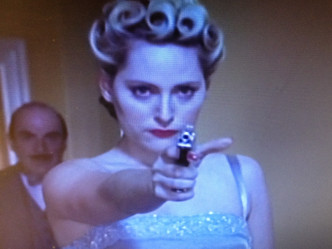
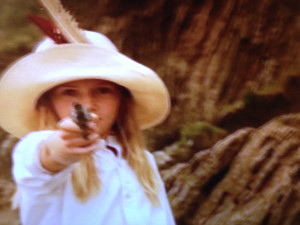
And Finally…
Even the ending is haunting.
In the final sequence, after Poirot has explained all, Lucy, still wearing her mother’s Alice Blue gown, turns her back on everyone and wanders through the shroud-bedecked hall of her old home back into the past – onto a sunlit terrace and into the arms of her parents once more. In the background, Gunning’s orchestration of Satie plays; it is not until the credits begin rolling that his Poirot theme is quietly and seamlessly introduced. Perfect.
In spite of a couple of needless ‘enhancements’, I think that this is the finest adaptation of any Poirot story that I have yet seen.
Selected Cast and Crew
AIMEE MULLINS (Lucy Crale)
AIDEN GILLEN (Amyas Crale)
RACHAEL STERLING (Caroline Crale)
TALULAH REILLY (Young Angela)
DAVID SUCHET (Hercule Poirot)
TOBY STEPHENS (Philip Blake)
JULIE COX (Elsa Greer / Lady Dittisham)
MARC WARREN (Meredith Blake)
GEMMA JONES (Cecilia Williams)
SOPHIE WINKELMAN (Angela Warren)
KEVIN ELYOT Screenplay
MARTIN FUHRER Cinematography
CHRISTOPHER GUNNING Music
PAUL UNWIN Director
MARGARET MITCHELL Producer
NOTES
¹ This is the piece playing at the top of this review. Recorded for Swigatha by the pianist Chris Long http://www.chrislongmusic.co.uk/ THANKS!
² I had originally included (with Christopher Gunning’s blessing) a snatch of his incidental music for this film, for a nominal fee agreed with the publisher. Then extras were added that made this too complex and expensive, so the link has been removed (with great reluctance!).
³ There is an excellent interview with the producer Margaret Mitchell that accompanies the DVD edition of Five Little Pigs, included in the box set of all 9 of the ITV Poirot series.
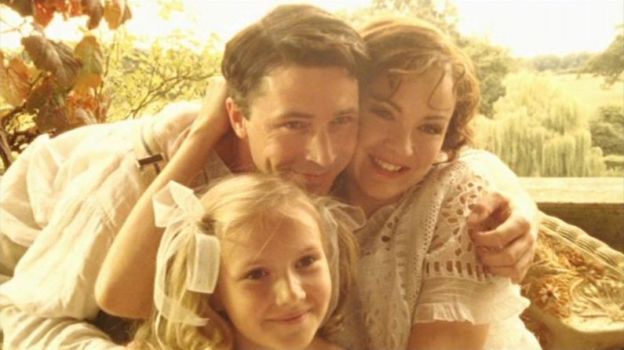
Pingback: Lektura na weekend – Zbrodnia z przeszłości - BLOG - PasjaPisania.pl
Pingback: Postings | Swigatha